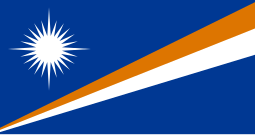Flag of the Marshall Islands
 | |
| Use | National flag |
|---|---|
| Proportion | 10:19 |
| Adopted | May 1, 1979 |
| Design | A blue field with two diagonal stripes of orange and white radiating from the lower hoist-side corner to the upper fly-side corner and the large white star with four large rays and twenty small rays on the upper hoist-side corner above the stripes. |
| Designed by | Emlain Kabua |

The First Lady of the republic.[1]
Rules and specifications regarding the flag are set forth in the Official Flag of the Marshall Islands Act 1979 (Public Law 1979–1).[2]
History
The Marshall Islands were part of the
Ebeye
. The flag is also the national flag with the most points on a star, at 24.
This flag placed ninth out of 72 - the best flag of an independent nation that isn't Canada or the United States, instead being in a free association with the United States - in a North American Vexillological Association poll that was held in 2001.[3]
-
 Flag of the Trust Territory of the Pacific Islands; was used in the RMI from 1965 to 1979
Flag of the Trust Territory of the Pacific Islands; was used in the RMI from 1965 to 1979 -
 The flag of the United States with 48 stars was also used in the RMI from 1944 to 1959 (see Timeline of the flag of the United States for more information on the stars on this flag increasing in number)
The flag of the United States with 48 stars was also used in the RMI from 1944 to 1959 (see Timeline of the flag of the United States for more information on the stars on this flag increasing in number)
Subnational flags
-
Flag of Ailuk Atoll
-
 Flag of Bikini Atoll from 1987 to the present
Flag of Bikini Atoll from 1987 to the present -
Flag of Ebon Atoll
-
Flag of Kwajalein Atoll
-
Flag of Majuro Atoll
-
Flag of Namdrik Atoll
-
Flag of Ujae Atoll
-
Flag of Wotho Atoll
Specifications

The flag has a ratio of 10:19. The star is situated such that its center is equidistant from the left edge, the top edge, and the top of the orange ray.
Colors
| Scheme | Dark Powder Blue | Fulvous | White |
|---|---|---|---|
RGB
|
0-56-147 | 221-117-0 | 255-255-255 |
CMYK
|
C1-M0-Y0-K42.3 | C0-M47-Y100-K13.3 | C0-M0-Y0-K0 |
| HEX | #003893 | #DD7500 | #FFFFFF |
References
- President of the Marshall Islands. Archived from the originalon August 5, 2013. Retrieved September 16, 2015.
- ^ "Marshall Island Revised Code 2014 (1 MIRC Ch. 3)". paclii.org. Pacific Islands Legal Information Institute. Retrieved September 1, 2016.
- ^ Kaye, Edward B. (June 10, 2001). "2001 State/Provincial Flag Survey" (PDF). Retrieved February 3, 2024.
External links















